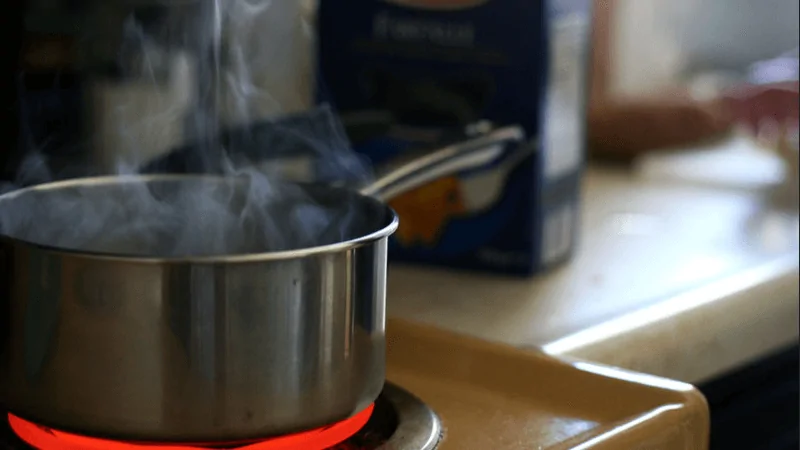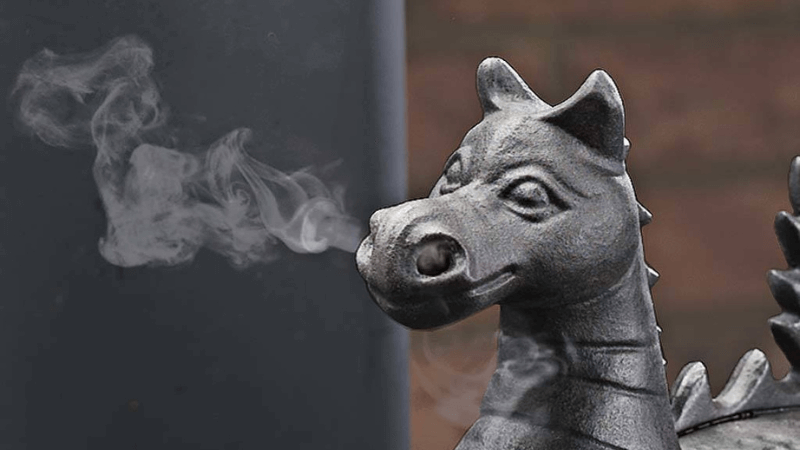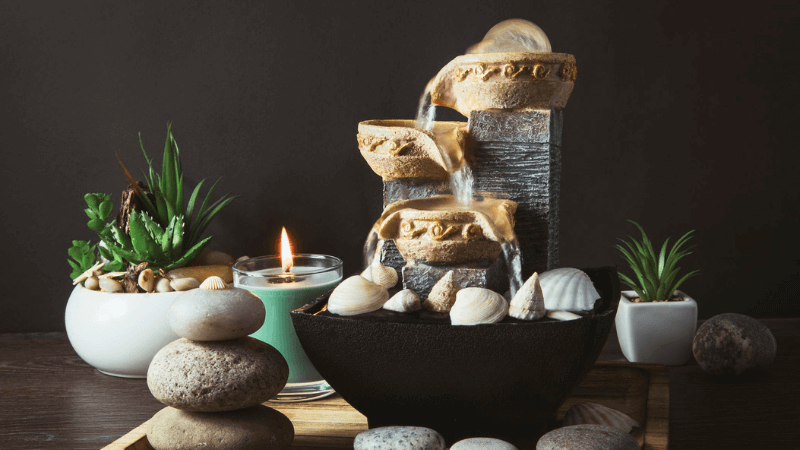Many homes become uncomfortable because dry air in the winter causes itchy skin, irritated sinus passages, and other health problems.
Humidifiers are a quick way to add and monitor the moisture in the air. However, if you lack a humidifier, there are humidifier alternatives and natural ways to humidify a room. These are cheap methods you can try today in your home to raise the humidity even without a humidifier.
1. Boil Water
Boiling water is perhaps one of the fastest ways of humidifying a room. Anyone can do this in their home because it does not require much effort to execute. Just take a pan or a pot, add water, turn the stove on and let it boil. The steam released into the air adds moisture to the surrounding areas.
Apart from boiling the water only, you can also take this chance and add essential oils to make the air more soothing and relaxing. A few drops of relaxing essential oils like lavender, lemongrass, or rose will do. Adding other essential oils can help fight germs and relieve coughs and colds.
[snippet]
Can dry air make you sick?
Yes. Dry air can cause a stuffy nose, cracked skin, and other health problems. It will also make your home uncomfortable and provide a thriving environment for viruses. According to an article by Nytimes, dry air makes the flu virus and other viruses stable and able to survive longer.
[/snippet]
To boil water, an electric kettle is better compared to a stove. It is more energy-efficient and heats water at a faster rate compared to a stove. You can also move it around the rooms to humidify other rooms too. For a good yet budget-friendly electric kettle, the Hamilton Beach Electric Tea Kettle, is a great option.
2. Get Houseplants
Plants lose water to the environment by a process called transpiration. While water is essential to a plant, only a small amount taken up by the roots is used for plant growth. The excess water is lost via aerial parts of the plant, such as the leaves, flowers, and stems. In your home, you can take advantage of this natural process to add moisture to your home.
However, keep the plants watered because a dry home can also be tough on them. House plants good at increasing humidity include Dracaena, Philodendron, Peace lily, Areca palm, and Bamboo palm, to mention a few.
3. Hang Your Clothes To Dry Indoors
Using a dryer is a common way of drying clothes. However, leaving your wet clothes hung inside your home is an excellent way of increasing the humidity naturally. As the clothes dry, water slowly evaporates, thus improving the humidity.
You can buy an indoor drying rack if you do not have clothes hangers installed in your home. Instead of a wall-mounted drying rack, you can get a collapsible one in which you can move to different rooms to provide moisture and improve the humidity. The AmazonBasics Foldable Clothes Drying Laundry Rack is a good cheap option you can try out. As a bonus, a drying rack will also make your home smell fresher.
4. Put Pots or Bowls of Water Near a Heat Source
When water is exposed to heat, it evaporates in the form of vapor. If you have a radiator in your home, place a ceramic or metallic water bowl next to it. You will be surprised by how the water is released. If you do not own a radiator, you can place the water bowl near a heat source. The same principle will apply even though the bowl is not directly on the heat source.
5. Cook On Your Stovetop
When do you cook, and how do you do it? Cooking on your stovetop can help increase the humidity by taking advantage of the incidental moisture release. When you cook, you can try making dishes that use boiling water, such as rice, pasta, or potatoes.
When water boils, some will evaporate into the air, thus increasing the moisture in the area and surroundings. Instead of using the microwave, you can make small changes like using a tea kettle to warm your cup.
6. Place Bowls Of Water Around the Room
Similar to using a bowl filled with water near a heat source, this technique uses heat to help water evaporate. However, instead of using heat from the stove or radiator, this uses the sun’s heat. On sunny days take a bowl of water and place it on the window sill. Ensure the curtains are open to allow sunlight to penetrate and heat the water.
The downside of this method is it can only be used on sunny days. In winter, the sun rarely comes out, which would limit this method to only those sunny, warm days. Apart from placing them on your window sill, you can also set the bowls around the room you want to humidify. This will also work but at a slower speed.
[snippet]
Does opening a window help with dry air?
Why would you need a humidifier when you can open your windows? Dry air is normally experienced during the winter season. Opening the windows is not only counter-productive but will also reduce the humidity levels in your home. Always keep your windows closed and use the methods above or, better yet, a humidifier to keep the humidity levels optimal.
[/snippet]
7. Use a Crock-Pot
Crock-pots are good at making a pot of stew; however, do you know you can use a pot also to humidify a room? A Crock-pot filled with water can serve effectively as a humidifier. To start:
- Fill the pot to about three-quarters.
- Cover the pot with a lid and turn it to its highest setting.
- Take it to a room you would like to increase the humidity and remove the lid to let the warm steam escape into the air.
Apart from adding moisture, you can add the baking powder into a crock-pot with some water. This will help humidify and freshen up a room or musty basements.
8. Use A Stove Steamer
If you regularly use a wood-burning stove, you can take advantage and get a cast iron steamer for your home. A stove steamer provides one of the best and fastest ways to add moisture to the air. All you have to do is fill the steamer with water and place it on your stove.
As the water gets heated, it will produce steam, which will increase the humidity. Unlike boiling water on a pot or pan, a stove steamer can also add to your home’s decor. You can buy a decorative one like the Dragon Wood Stove Steamer.
9. Sponge Humidifier
Besides cleaning your car or dishes, a sponge can also help to humidify a room. There are two ways you can go about using the sponge.
First, take the sponge and soak it in water. Squeeze the sponge to remove any excess water. Take a plastic bag and cover the sponge. Puncture the plastic bag with a series of small holes and place it in the room you desire to increase the humidity. Depending on the size of the room, you will require more than one sponge to reach the desired humidity.
A second approach to using a sponge as a DIY humidifier involves a fan and a pan. First, cut the sponge into several pieces that fit into the pan. Add hot water to the pan till it’s half full. Immerse the pieces of sponge into the pan and let them soak for a few minutes. Take the pan with the pieces of sponge and place it in front of your fan. Tilt the pan by 15-45 degrees, so the fan blows over the pan. This should help humidify the room.
[snippet]
Does a diffuser add moisture to the air?
Yes. An essential oil diffuser will add moisture to the air. However, a diffuser’s sole purpose is to diffuse essential oils in the air. So when you use a diffuser to humidify, it will only improve the humidity by a small percentage. If you want to diffuse and humidify simultaneously, you can try a humidifier diffuser combo. Read our in-depth article on humidifiers vs. diffusers.
[/snippet]
10. Use a Spray Bottle
A spray bottle like the ones for plants, pets, or cleaning products can also work to improve the humidity. Fill the bottle with either cold or warm water and spray it into the air now and then.
The finer the mist from the spraying bottle, the better and more effective it will work. However, it would help if you were careful not to spray more water than what can evaporate quickly, or you might damage your furniture, bedding, or carpet.
11. Dampen Your Curtains
Spraying your curtains is another great way to add moisture to your home. Take a spraying bottle and dampen the curtains. If a spraying bottle is unavailable, you can use your hand and sprinkle water evenly on the curtain. For this to work, the curtains have to be exposed to sunlight. This will help evaporate the water into the room. You can open the windows and let the air blow through the curtains to speed up things.
12. Vent Your Electric Clothes Dryer Inside
If you have an electric dryer, you can use it in your home during some times of the year, like winter, when the air is dry, and the weather is cold. Dryers use a lot of energy. They suck the air in your home, warm it up and blow the hot air into your clothes. Through this process, the hot air and moisture from your clothes go out through the vent pipe. All the heat and moisture are lost when you vent the dryer outside. However, you can do something about this – vent the dryer into your home.
The moisture will prevent excessive dryness in the house, and you can save a lot of energy and money on heating. To keep lint from entering your home, add a metallic filter over the end of the pipe to catch the lint. If you use a gas dryer, do not consider this option. This is because the exhaust vent also works as the combustion vent. This will add combustion products, such as carbon monoxide gas, to your home.
[snippet]
Can a dehumidifier make the air too dry?
Yes. A dehumidifier can remove excess moisture in the air, which will cause dry air. This will create a set of other problems associated with dry air. To avoid this, you can get a dehumidifier with a built-in humidistat. It will automatically power off at the ideal humidity levels. You can also consult with professionals who will know the match the needs of your home and correctly set up the dehumidifier.
[/snippet]
13. Leave The Bathroom Door Open While Taking a Shower
If you enjoy hot showers, you can take advantage of this situation and add moisture to your home by leaving the bathroom door open. Leaving the door open when taking a shower helps steam escape. This helps in improving the humidity in the surrounding areas. However, this option might have limitations. This might work if you live alone or with people who respect your privacy. However, in other cases leaving the bathroom open might not be an option.
14. Leave Water in The Bath Tub
After taking a shower, you can leave it for up to one hour instead of immediately draining the water. As the water cools down, it will slowly evaporate, humidifying the bathroom and adjacent rooms. However, also remember to keep the bathroom door open.
15. Use a Damp Towel
A damp towel placed on a heat vent can also improve the humidity. Soak the towel in water and put it on a heat vent. When the towel dries, immerse it in water and place it on the vent again. You can use multiple towels to increase the humidity faster. Aside from putting a damp towel over a heat vent, you can also hang the towels from the blades of your ceiling fan when it’s not running.
16. Leave The Dishwasher Door Open
Some dishwashers will automatically open the door at the end of the wash period to allow the dishes to dry. After a wash, you can bypass the drying cycle and let the dishes air dry. This will enable the steam to escape and moisten your indoor air. It will save you a lot of energy by not running the heated drying cycle.
17. Try an Indoor Fountain
An indoor fountain or waterfalls are a great idea to improve the humidity. For homeowners, an indoor fountain will also be a decorative and permanent solution to help keep dry air at bay. An indoor fountain, waterfall, or other water features around your home act as natural humidifiers. When the air is dry, the water will evaporate.
Though slow, this process will humidify your home and prevent over-humidification. The good thing is that water features require less maintenance, and because they are versatile, you can get one personalized to fit your home and budget.
How to Measure Humidity
Keeping track of your home’s humidity level can help you fix the dry air problems before it gets too severe. To measure your home’s humidity, you can purchase a hygrometer at a local hardware store or home store. Once you have bought a hygrometer, pick a location in your home where you spend most of your time and place there.
Avoid placing the hygrometer near doors, humidifiers, heaters, or air conditioners. Once the hygrometer is set up in your chosen location, leave it for a few hours to get a better reading. Taking the reading right after placing the humidifier will likely result in a false reading.
[snippet]
What causes dry air in your house?
Dry air is experienced mainly in the winter season. During the winter season, humidity is very low, and it is also freezing. Thus in most households, people crank up the heat to add warmth. This, in effect, only works to lower the already small amount of moisture in the air.
[/snippet]
Happy Humidifying
Keeping your home humidity at optimal levels should not be hard if you do not own a humidifier. Our 17 methods are proven and should be easy to implement in your home without much hassle.








